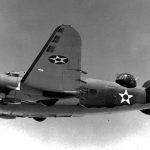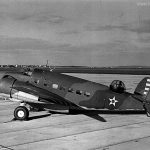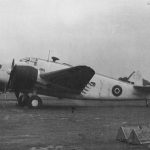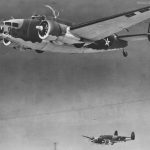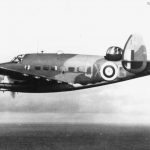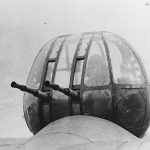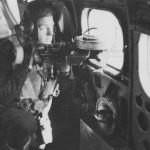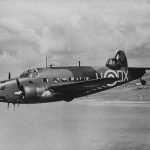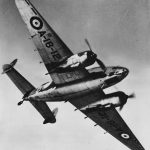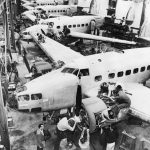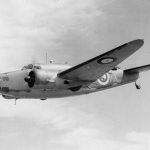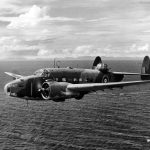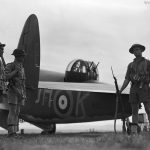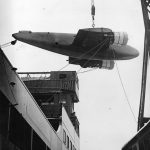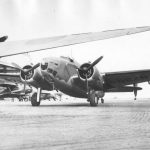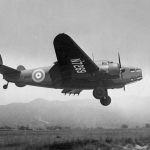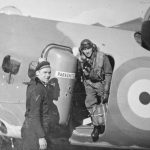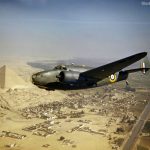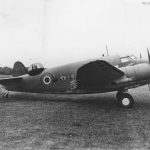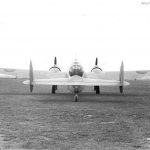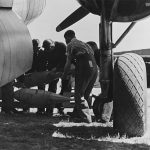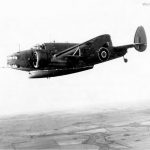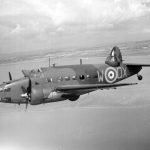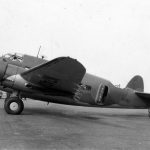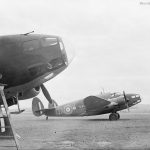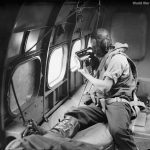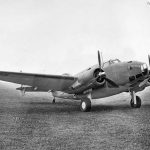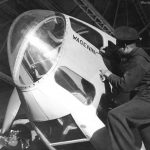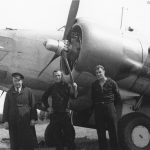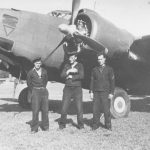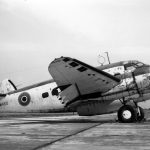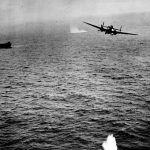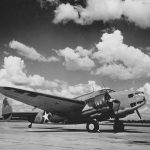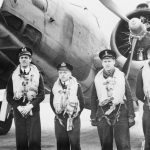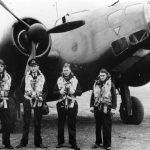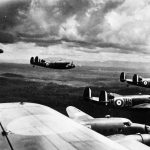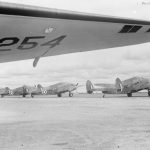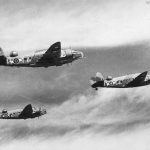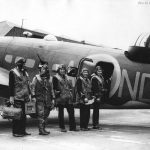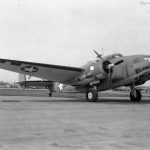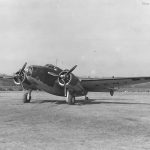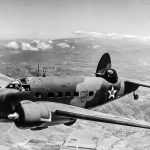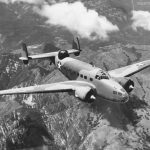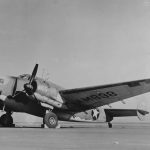wireless operator of a Hudson
RAAF crew prepares Hudsons
Hudsons Mk.IV of No.8 Squadron, RAAF, with an escorting Commonwealth CA-3 Wirraway of No.21 Squadron, over Malaya before the Japanese attack
Production Line Lockheed Plant Burbank
PBO-1 Hudson
PBO-1 Hudson
Hudson V AM865
Hudson wingtip
Lockheed AT-18 Hudson
Lockheed Burbank 1941
PBO-1 Hudson VP-82 in flight
Hudson Mk V 224 Sqn
Hudson V AM753 with underwing rocket rails
Hudson P5120 VX-C June 1940
Hudson VI FK618
Boulton Paul turret
Lockheed Hudson USA
Gunner with Vickers machine gun mounted in the sude window of the cabin
Hudson Transport Command North Africa
Hudson Tjimanoek No. 320 (Netherlands) Squadron RAF
Hudson T9465 “Spirit of Lockheed-Vega Employees”
Hudson T9364 “Ypenburg” of 320 Squadron 1941
Hudson T9277 August 1940
Australian Hudson 1941 in flight
Hudson Production Line at Lockheed Plant in Burbank
Crew with Hudson T9465 May 1941
Hudson Rear Gunner
Hudson Production Burbank
Hudson Production Burbank
Hudson P5143 VX-B 206 Sqn, June 1940
Hudson OY-E 48 Sqn in flight
New Zealand Hudson NZ2090 3 Sqn July 1943
Hudson NZ2047 UH-K of 2 Squadron Nelson 1942
Hudson NZ2004 Hobsonville
Hudson N7401 Floyd Bennett Field
Hudson N7366 Arrive England Port
Hudson N7364
Hudson N7284
Damaged Hudson N7264
Hudson N7269 Burbank
Hudson N7280
The Duke of Kent steps out of the Hudson in which he flew to the RAF station
Hudson N7205
Hudson MK VI of Royal Netherlands Air Force
Hudson Mk IV AE626, Egypt
Hudson Mk IV AE628 Eastleigh
Hudson Mk I
Hudson Mk.III July 1942
Hudson bombing-up
Hudson carrying airborne lifeboat
Hudson Mk.I T9277 QX-W of No. 224 Squadron RAF
Hudson I N7401
Hudson I N7315 224 Sqn
Hudson I interior 269 Sqn
Hudson I interior
Hudson I 206 Squadron
Hudson IV
Hudson II T9376 206 Sqn in flight
Hudson interior
Hudson III V9122 No. 320 Squadron RAF
Hudson III V9105 48 Sqn in flight
Royal Netherlands Air Force Hudson III V9041
Hudson III V8977
Hudson IIIA T9465 Spirit of Lockheed-Vega Employees Iceland 1941
Dutch Hudson III T9440 Tello of No. 320 Squadron RAF
Hudson IIIA BW450 1946
Hudson Dunkirk 1940
Hudson bomb bay
Hudson bomb bay 224 Sqn
ground crew loading bombs onto a Hudson
Hudson Coastal Command
Hudson cockpit
Hudson bomb-aimer
Hudson attacking shipping
Hudson AM665 in USA
Hudson AM591 during test flight in USA
Hudsons OD-K, OD-J and OD-N
Hudson AE596 “White 168”
Hudson AE623 of No. 206 Squadron RAF
Hudson 407 Sqn December 1943
Hudson with ASV radar 320 Squadron
Hudson with ASV radar
Hudson 320 Sqn
Hudsons Mk V during completion prior delivery
Hudsons RAAF 8 Squadron in Singapore
Hudson Mk I 206 Squadron
Hudsons Mk V April 1941
Hudsons over Malaya
Hudsons III Gander
Hudsons 4 Squadron RNZAF: YZ-F, YZ-O and YZ-F
Hudsons of No. 3 Squadron RNZAF Guadalcanal 1943
Coastal Command Hudson serviced at Azores Base 1944
Coastal Command Hudson VI rockets
Crew boards a Hudson
Damaged Hudson
Dutch Hudson Scotland
British Airman Views Damage to Hudson
AT-18 Hudson
AT-18A Hudson Navigation trainer
A-29 Hudson 41-23415 6232
A-29 Hudson in flight
A-29A Hudson
A-28A Hudson AM898 “white 165”
The political crisis at the end of the 1930s made the RAF command realise that the British aviation industry would not be able to produce a sufficient number of modern aircraft in the short term. Therefore, in April 1938, a purchasing committee was sent to the USA to organise the supply of the most needed types of military aircraft. Among other things, 250 Hudson aircraft were purchased. It was based on the Lockheed 14 Super Electra passenger and transport plane, the prototype of which was flown on 29 June 1937. Lockheed Aircraft Corporation did not build or develop military aircraft, however, its constructors envisaged a quick conversion of civil aircraft into military ones. Therefore, Lockheed built a mock-up of a transport and combat aircraft in four days, which attracted the attention of the British. They concluded that it would make an excellent maritime patrol aircraft. The designer of the aircraft was Clarence “Kelly” Johnson. The aircraft was initially designated B-14, later B-141 and L-214 “Hudson”.
A great advantage of the Hudson was its spacious fuselage, accommodating 4 crewmen and 1,500 kg of bombs. In the nose part of the fuselage could be installed 2 fixed machine guns. The British requested an armament upgrade with 2 machine guns housed in a spherical Boulton-Paul turret on the back of the fuselage. The aircraft was powered by two Wright GR-1820-G102A radial engines. All armament was of British production, calibre 7.7mm (.303). The reinforcement of the armament reduced the bomb payload to 1,400 lb (635 kg). On 25.07.1938 the British signed a contract for the delivery of Hudson Mk.I aircrafts with the delivery date to December 1939. Lockheed immediately started to prepare the serial production and the first serial aircraft was flown on 10 December 1938. In February 1939 the first Hudsons were delivered to Great Britain. The first delivered aircraft were used for trials and crew training. Lockheed delivered the ordered 250 aircraft two months ahead of schedule. Of these, 28 were delivered to the RCAF (serials: 759-786) and a further 3 were delivered to the SAAF in 1940.
In April (according to other sources – in May) 1939, the crews of No. 224 Squadron RAF began regular patrols over the North Sea with these aircraft. The operation of the RAF patrol squadrons became particularly important at the beginning of the Second World War. For Britain, maintaining control of its sea lanes of communication was vital at the time. In early 1940, radars for the detection of submarines, ASW Mk.I, began to be installed on the Hudsons for the first time. Aircraft of this type actively participated in numerous clashes over the sea, achieving considerable success in combat in the early stages of the war. Hudson became the first RAF aircraft to shoot down a German plane operating from the British Isles, it was on 8 October 1939. Hudsons participated in the evacuation of troops at Dunkirk in May-June 1940, they attacked the German battleship Sharnchorst in June of the same year. They were used by the RAF in special task squadrons: 161 in Europe and 357 in Burma.
Hudsons were in fact multi-purpose aircraft, used as long-range maritime patrol, anti-submarine, air transport, diversion group drops, weather reconnaissance and transport aircraft. Between 1938 and 1943, 2,941 aircraft of all versions were built. Hudson was the basis for the development of the new Lockheed Ventura aircraft.
Variants and serials:
Mk.I – the first version built to RAF order, powered by Wright GR-1820-G102A engines producing 809 kW (1100 hp). 351 examples were built for the RAF (N7205-N7404, P5116-P5165, T9266-T9365 and R4059)and 50 examples for the RAAF (A16-1 – A16-50).
Mk.II- externally did not differ from the Mk.I, its construction was strengthened and having constant-speed propellers. Built 20 copies for the RAF (T9366-T9385) and 50 copies for the RAAF.
Mk.III – version combining airframe of Mk.II version with Wright GR-1820-G205A engines with 882 kW (1200 hp). The aircraft could be armed with machine guns installed in the windows of the cargo cabin and was adapted for flights over the sea. 428 examples were built. RAF serials: T9386-T9465, V8975-V8999, V9020-V9069, V9090-V9129, V9220-V9254. AE485-AE608 and AM930- AM953.
Mk.III (LR)- III with extra fuel tanks, increasing maximum capacity from 2,438 to 3,892 litres.
C.Mk III – transport aircraft VJ416 and VJ421.
Mk.IIIA- similar to the Mk.III version, but equipped with Wright R-1820-87 engines with 882 kW (1200 hp). Delivered to the United Kingdom and British Commonwealth countries. The aircraft were also supplied to the US military aviation under the designation A-29 and to the US Navy aviation as PBO-1. 800 examples were built, including 384 examples of the military transport variant designated A-29A.
Mk.IV – designation of aircraft used in RAAF (A16-51 – A16-100), which received Pratt & Whitney “Twin Wasp” engines S3C-G with 772 kW (1050 hp). RAF serials: (AE609 – AE638).
Mk.IVA- designation for 52 aircraft in the RAAF, delivered under Lend Lease.
Mk.V- a version similar to the Mk.III, but with Pratt & Whitney “Twin Wasp” engines S3C4-G with 882 kW (1200 hp). 409 examples were built, serials AE639 -AE657 and AM520 – AM702.
Mk.V (LR) – V with extra fuel tanks (AM703 – AM909)
Mk.VI- version similar to Mk.III, but equipped with Pratt & Whitney R-1830-67 engines with 882 kW (1200 hp). 450 examples were built.
C Mk.VI- designation for Mk.VI transport aircraft used in the RAF, did not have armament.
A-28- equivalent to the Mk.IV and Mk.IVA versions intended for RAAF, which received 52 aircraft (A16-101 – A16-152).
A-28A- designation of the Mk.VI version intended for the RAF (EW873-EW972 and FK381-FK730). USSAF serials: 42-6582 – 42-6681 and 42-46937 – 42-47286.
A-29 -similar to the A-28 version, powered by 882 kW (1200 hp) R-1820-87 engines. 416 were built for the RAF (BW361-BW766, BW768-BW777 and FH167-FH366), 153 went to the USAAF as RA-29 (41-23223 – 41-23628, 41-23630 – 41-23639 and 41-36968 – 41-37167) and 20 to the US Navy as PBO-1 BuNos 03842 – 03861.
A-29A – a version of the A-29 adapted to the role of a transport aircraft. 384 were built for the RAF as Mk.IIIA, several were used by the USAAF as RA-29A (according to other sources – equivalent to the Mk.VI version, intended for the USAAF). Serials: BW767 41- 23629; FH367-FH466, 41-37168 – 41-37267; and FK731-FK813, 42-47287 – 42-47369.
A-29B – designation of 24 aircraft of the A-29A version in the photo reconnaissance variant.
AT-18 – a training version delivered to the USAAF, equipped with R-1820-87 engines of 882 kW (1200 hp) and a Martin gun turret used for on-board gunner training. 217 examples were built (42-55568 – 42-55784).
AT-18A- a version similar to the AT-18 with R-1820-87 engines, designed for navigator training. Supplied to the USAAF (42-55485 – 42-55567), 83 were built.
C-63 – provisional designation of the A-29A version.
B-14S – designation of one aircraft delivered to Sperry, used as a test aircraft for new equipment.
General Specifications
- Type: Twin-engined general-purpose monoplane.
Wings
- Configuration: Mid-wing cantilever monoplane.
- Structure: Consists of three sections with a single spar and stressed-skin covering.
- Fuel Tanks: Built-in fuel tanks in the center-section.
- Flaps and Ailerons: Equipped with Lockheed-Fowler flaps that slide back 42 inches in streamline guides. Ailerons are interconnected to droop with the flaps. Low-drag slots are located in each wingtip in front of the ailerons.
Fuselage
- Structure: Elliptical cross-section monocoque of all-metal, flush-riveted construction.
Tail Unit
- Configuration: Cantilever monoplane type with twin fins and rudders.
- Material: All-metal construction.
Landing Gear
- Type: Retractable, with wheels retracting backwards into the engine nacelles.
- Operation: Hydraulic retraction with an emergency hand operation.
Power Plant
- Engines:
- Wright Cyclone (for Hudson I, II, and III variants)
- Pratt & Whitney Twin-Wasp (for Hudson IV and V variants)
- Propellers: Hamilton-Standard constant-speed airscrews.
- Other Features: NACA cowlings and built-in fuel tanks in the center-section.
Accommodation
- Crew: Normal crew of five.
- Positions:
- Bomb-aimer’s position in the nose.
- Pilot and navigator situated over the leading edge of the wing.
- Radio operator and rear gunner located in the cabin over the wing.
- Positions:
Armament
- Machine Guns:
- Two fixed 0.303 in. Browning machine guns in the top of the fuselage in front of the pilot.
- Boulton Paul turret with two 0.303 in. Browning guns at the aft end of the fuselage near the tailplane.
- Two 0.303 in. Browning guns on beam mountings, one on each side of the fuselage.
- One 0.303 in. Browning gun in a retractable prone position beneath the cabin floor.
- Total Armament Load: 1,400 lbs.
Dimensions
- Span: 65 ft. 6 in. (19.95 m)
- Length: 44 ft. 4 in. (13.4 m)
- Height: 11 ft. 10½ in. (3.63 m)
- Wing Area: 551 sq. ft. (51.2 sq. m)
Weights
- Empty Weight: 12,536 lbs. (5,690 kg)
- Loaded Weight: 18,500 lbs. (8,400 kg)
Performance
- Maximum Speed: 275 mph (440 km/h)
- Cruising Speed: 223 mph (356.8 km/h) at 8,000 ft. (2,440 m)
- Landing Speed: 72 mph (115.2 km/h)
- Service Ceiling: 24,500 ft. (7,470 m)
Source:
Francillon, René J.: Lockheed Aircraft since 1913
Profile Publications 253 – Lockheed Hudson Mks I To VI




